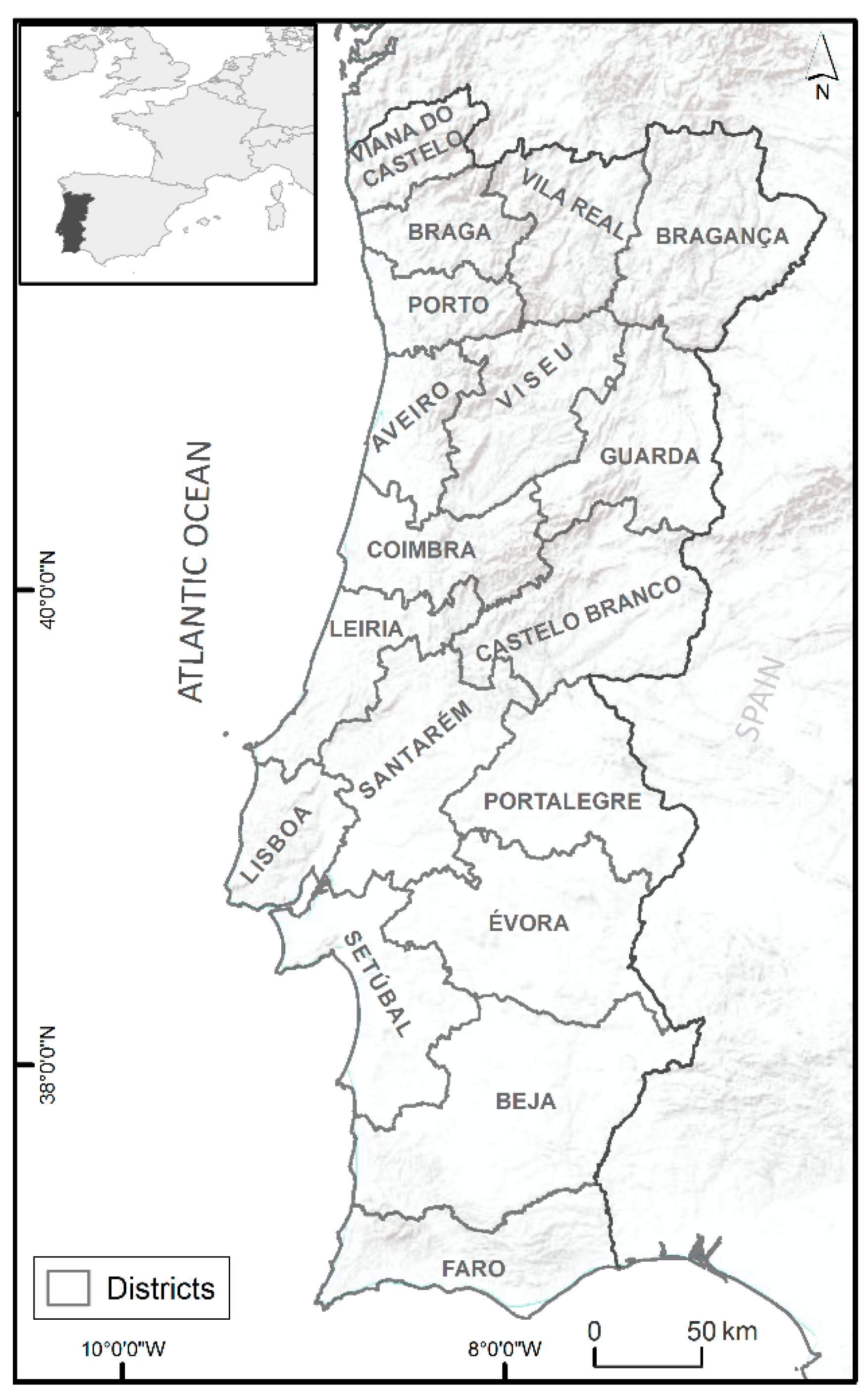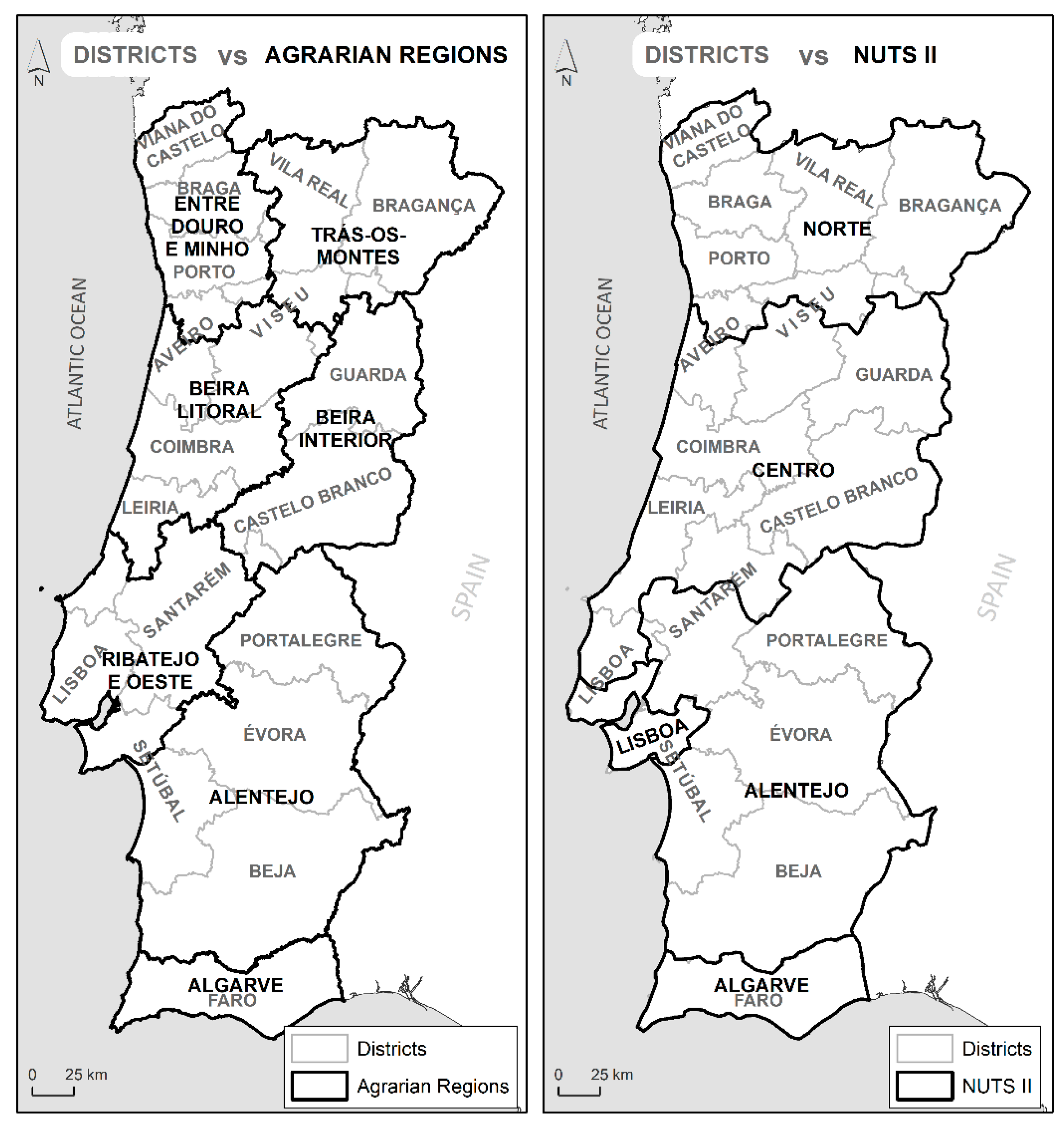Evolution of Agricultural Production in Portugal during 1850–2018: A Geographical and Historical Perspective
Abstract
:1. Introduction
2. Materials and Methods
2.1. Study Area
2.2. Portuguese Agricultural Statistical Data
Data Homogenization
2.3. Long-Term Spatiotemporal Interpretation and Trend Analysis
3. Results
3.1. Overview of Wheat, Maize, and Rice National Production
3.2. Regional Long-Term Spatiotemporal Analysis
3.3. Spatiotemporal Pattern and Trends Analysis
4. Discussion
4.1. Visualisation, Description, and Interpretation of the Regional Productions
4.2. Data Homogenisation
4.3. Data Inconsistencies
5. Conclusions
Author Contributions
Funding
Acknowledgments
Conflicts of Interest
References
- Mitchell, B.R. International Historical Statistics; Palgrave Macmillan: London, UK, 1998. [Google Scholar]
- Mitchell, B.R. British Historical Statistics; Cambridge University Press: Cambridge, MA, USA, 2011; ISBN 9781107402447. [Google Scholar]
- Westlund, H.; Nilsson, P. Agriculture’s transformation and land-use change in a post-urban world: A case study of the Stockholm region. J. Rural Stud. 2019. [Google Scholar] [CrossRef]
- Calleja, E.J.; Ilbery, B.; Mills, P.R. Agricultural change and the rise of the British strawberry industry, 1920–2009. J. Rural Stud. 2012, 28, 603–611. [Google Scholar] [CrossRef]
- Eurostat. Regional Yearbook: 2020 Edition; Publications Office of the European Union: Luxembourg, 2020; ISBN 978-92-76-20729-0. [Google Scholar]
- Freire, D.; Lains, P. An Agrarian History of Portugal, 1000–2000: Economic Development on the European Frontier; Freire, D., Lains, P., Eds.; Brill: Leiden, The Netherlands, 2017. [Google Scholar]
- Justino, D. A Formação do Espaço Económico Nacional. Portugal: 1810–1913; Vega: Lisboa, Portugal, 1988; Volume 2. [Google Scholar]
- Lains, P.; Silveira E Sousa, P. Estatística e Produção Agrícola em Portugal, 1848–1914***. Análise Soc. 1998, XXXIII, 935–968. [Google Scholar]
- Pereira, M.H. Livre-Câmbio e Desenvolvimento Económico; Sá da Costa: Lisboa, Portugal, 1983. [Google Scholar]
- Gregory, I.; Ell, P. Breaking the boundaries: Geographical approaches to integrating 200 years of the census. J. R. Stat. Soc. Ser. A Stat. Soc. 2005, 168, 419–437. [Google Scholar] [CrossRef]
- Murrieta-Flores, P.; Martins, B. The geospatial humanities: Past, present and future. Int. J. Geogr. Inf. Sci. 2019, 33, 2424–2429. [Google Scholar] [CrossRef] [Green Version]
- Boivin, N.; Crowther, A. Mobilizing the past to shape a better Anthropocene. Nat. Ecol. Evol. 2021, 5, 273–284. [Google Scholar] [CrossRef]
- Gregory, I.; Dorling, D.; Southall, H. A century of inequality in England and Wales using standardized geographical units. Area 2001, 33, 297–311. [Google Scholar] [CrossRef]
- Ribeiro, O.; Lautensach, H.; Daveau, S. Geografia de Portugal; Sá da Costa: Lisboa, Portugal, 1988; ISBN 9789729230158. [Google Scholar]
- Lains, P. Os Progressos do Atraso: Uma Nova História Económica de Portugal, 1842–1992; Instituto Ciencias Sociais da Universidade de Lisboa: Lisboa, Portugal, 2003; ISBN 9789726711094. [Google Scholar]
- Van Zanden, J.L.; van Leeuwen, B. Persistent but not consistent: The growth of national income in Holland 1347–1807. Explor. Econ. Hist. 2012, 49, 119–130. [Google Scholar] [CrossRef]
- Thomas, R.W. Modelling in Geography: A Mathematical Approach; Harper & Row: Manhattan, NY, USA, 1980; ISBN 9780063180604. [Google Scholar]
- Comber, A.; Zeng, W. Spatial interpolation using areal features: A review of methods and opportunities using new forms of data with coded illustrations. Geogr. Compass 2019, 13, 1–23. [Google Scholar] [CrossRef] [Green Version]
- Penghui, J.; Dengshuai, C.; Manchun, L. Farmland landscape fragmentation evolution and its driving mechanism from rural to urban: A case study of Changzhou City. J. Rural Stud. 2021, 82, 1–18. [Google Scholar] [CrossRef]
- Gale, H.F. Age cohort analysis of the 20th century decline in U.S. farm numbers. J. Rural Stud. 1996, 12, 15–25. [Google Scholar] [CrossRef]
- Langford, M.; Maguire, D.; Unwin, D.J. The areal interpolation problem: Estimating population using remote sensing in a GIS framework. In Handling Geographical Information: Methodology and Potential Applications; Masser, I., Blakemore, B., Eds.; Longman Scientific & Technical: Essex, UK, 1991; pp. 55–77. [Google Scholar]
- Gregory, I. The accuracy of areal interpolation techniques: Standardising 19th and 20th century census data to allow long-term comparisons. Comput. Environ. Urban Syst. 2002, 26, 293–314. [Google Scholar] [CrossRef]
- Goodchild, M.F.; Lam, N. Areal Interpolation: A Variant of the Traditional Spatial Problem. Geo-Processing 1980, 1, 297–312. [Google Scholar]
- Fisher, P.F.; Langford, M. Modelling the Errors in Areal Interpolation between Zonal Systems by Monte Carlo Simulation. Environ. Plan. A Econ. Space 1995, 27, 211–224. [Google Scholar] [CrossRef]
- Langford, M. Obtaining population estimates in non-census reporting zones: An evaluation of the 3-class dasymetric method. Comput. Environ. Urban Syst. 2006, 30, 161–180. [Google Scholar] [CrossRef]
- Hallisey, E.; Tai, E.; Berens, A.; Wilt, G.; Peipins, L.; Lewis, B.; Graham, S.; Flanagan, B.; Lunsford, N.B. Transforming geographic scale: A comparison of combined population and areal weighting to other interpolation methods. Int. J. Health Geogr. 2017, 16, 29. [Google Scholar] [CrossRef] [PubMed] [Green Version]
- Gregory, I.; Southall, H. The Great Britain Historical GIS. Hist. Geogr. 2005, 33, 132–134. [Google Scholar]
- Schroeder, J.P. Target-Density Weighting Interpolation and Uncertainty Evaluation for Temporal Analysis of Census Data. Geogr. Anal. 2007, 39, 311–335. [Google Scholar] [CrossRef]
- Gregory, I.; Ell, P. Error-sensitive historical GIS: Identifying areal interpolation errors in time-series data. Int. J. Geogr. Inf. Sci. 2006, 20, 135–152. [Google Scholar] [CrossRef]
- Han, J.; Kamber, M.; Pei, J. Data Mining: Concepts and Techniques; Elsevier Inc.: Amsterdam, The Netherlands, 2012; ISBN 9780123814791. [Google Scholar]
- Yue, S.; Pilon, P.; Cavadias, G. Power of the Mann-Kendall and Spearman’s rho tests for detecting monotonic trends in hydrological series. J. Hydrol. 2002, 259, 254–271. [Google Scholar] [CrossRef]
- Getis, A.; Ord, J.K. The Analysis of Spatial Association by Use of Distance Statistics. Geogr. Anal. 2010, 24, 189–206. [Google Scholar] [CrossRef]
- Khaliq, M.N.; Ouarda, T.B.M.J.; Gachon, P.; Sushama, L.; St-Hilaire, A. Identification of hydrological trends in the presence of serial and cross correlations: A review of selected methods and their application to annual flow regimes of Canadian rivers. J. Hydrol. 2009, 368, 117–130. [Google Scholar] [CrossRef]
- Avillez, F. A Agricultura Portuguesa; Fundação Francisco Manuel dos Santos: Lisbon, Portugal, 2015; ISBN 9789898819000. [Google Scholar]
- Pais, J.M.; De Lima, A.M.V.; Baptista, J.F.; de Jesus, M.F.M.; Gameiro, M.M. Elementos para a história do fascismo nos campos: A «Campanha do Trigo»: 1928-38 (I). Análise Soc. 1976, 12, 401–473. [Google Scholar]
- Rosas, F. Rafael Duque e a política agrária do Estado Novo (1934–1944). Análise Soc. 1991, 26, 771–790. [Google Scholar]
- Jones, N.; de Graaff, J.; Rodrigo, I.; Duarte, F. Historical review of land use changes in Portugal (before and after EU integration in 1986) and their implications for land degradation and conservation, with a focus on Centro and Alentejo regions. Appl. Geogr. 2011, 31, 1036–1048. [Google Scholar] [CrossRef]
- Harris, N.L.; Goldman, E.; Gabris, C.; Nordling, J.; Minnemeyer, S.; Ansari, S.; Lippmann, M.; Bennett, L.; Raad, M.; Hansen, M.; et al. Using spatial statistics to identify emerging hot spots of forest loss. Environ. Res. Lett. 2017, 12, 024012. [Google Scholar] [CrossRef]
- Murakami, D.; Tsutsumi, M. A New Areal Interpolation Method Based on Spatial Statistics. Procedia Soc. Behav. Sci. 2011, 21, 230–239. [Google Scholar] [CrossRef] [Green Version]
- Kounadi, O.; Ristea, A.; Leitner, M.; Langford, C. Population at risk: Using areal interpolation and Twitter messages to create population models for burglaries and robberies. Cartogr. Geogr. Inf. Sci. 2018, 45, 205–220. [Google Scholar] [CrossRef]
- Huyen Do, V.; Thomas-Agnan, C.; Vanhems, A. Spatial reallocation of areal data—Another look at basic methods. Rev. d’Économie Rég Urbaine 2015, 1–2, 27–58. [Google Scholar] [CrossRef]
- Geddes, A.; Elston, D.A.; Hodgson, M.E.A.; Birnie, R.V. Stochastic model-based methods for handling uncertainty in areal interpolation. Int. J. Geogr. Inf. Sci. 2013, 27, 785–803. [Google Scholar] [CrossRef]
- Thevenin, T.; Mimeur, C.; Schwartz, R.; Sapet, L. Measuring one century of railway accessibility and population change in France. A historical GIS approach. J. Transp. Geogr. 2016, 56, 62–76. [Google Scholar] [CrossRef]










Publisher’s Note: MDPI stays neutral with regard to jurisdictional claims in published maps and institutional affiliations. |
© 2021 by the authors. Licensee MDPI, Basel, Switzerland. This article is an open access article distributed under the terms and conditions of the Creative Commons Attribution (CC BY) license (https://creativecommons.org/licenses/by/4.0/).
Share and Cite
Viana, C.M.; Freire, D.; Abrantes, P.; Rocha, J. Evolution of Agricultural Production in Portugal during 1850–2018: A Geographical and Historical Perspective. Land 2021, 10, 776. https://doi.org/10.3390/land10080776
Viana CM, Freire D, Abrantes P, Rocha J. Evolution of Agricultural Production in Portugal during 1850–2018: A Geographical and Historical Perspective. Land. 2021; 10(8):776. https://doi.org/10.3390/land10080776
Chicago/Turabian StyleViana, Cláudia M., Dulce Freire, Patrícia Abrantes, and Jorge Rocha. 2021. "Evolution of Agricultural Production in Portugal during 1850–2018: A Geographical and Historical Perspective" Land 10, no. 8: 776. https://doi.org/10.3390/land10080776
APA StyleViana, C. M., Freire, D., Abrantes, P., & Rocha, J. (2021). Evolution of Agricultural Production in Portugal during 1850–2018: A Geographical and Historical Perspective. Land, 10(8), 776. https://doi.org/10.3390/land10080776








